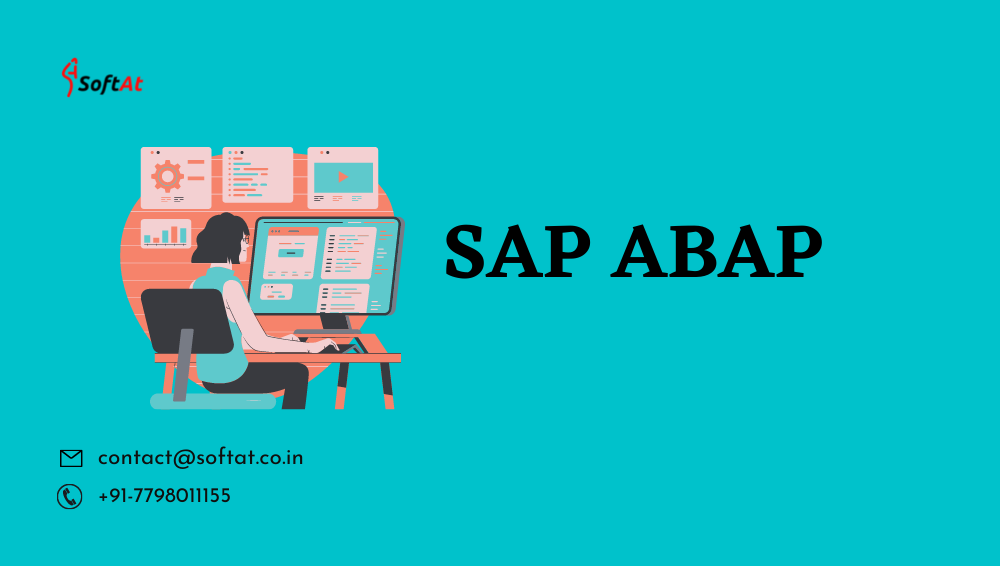What is ABAP?
SAP ABAP (Advanced Business Application Programming) is a high-level programming language created by SAP that helps large corporations to customize the SAP ERP. Financial accounting, materials management, asset management, and all other SAP modules can benefit from ABAP customization. NetWeaver, SAP’s current development platform, supports both ABAP and Java.
ABAP Language
Here are the reasons for using SAP ABAP language:
- It is a simple language that is easy to learn when it comes to programming.
- It is used by developers to develop the SAP R3 Platform.
- It allows you to choose from procedural and object-oriented programming.
- It also SAP customers to improve their SAP-based applications.
- This language is quite for programmers. However, it is not the right tool that can be used by non-programmers.
SAP ABAP (Advanced Business Application Programming) Programs
As in other programming languages, an ABAP program is either an executable unit or a library, which provides reusable code to other programs and is not independently executable.
It distinguishes two types of executable programs:
- Reports
- Modules
Reports follow a relatively simple programming model in which a user enters a set of parameters (e.g., a selection over a subSET of data) that the computer then utilizes to generate a report in the form of an interactive list. The name “report” can be deceptive because reports can also be used to edit data; the reason these programs are called reports is
that the output they create is “list-oriented”.
Module pools define more complex patterns of user interaction using a collection of screens. The physical image that the user sees is referred to as the “screen”. Each screen also has a “flow logic”, which is divided into “PBO” (Process Before Output) and “PAI” (Process After Input) sections and refers to the ABAP(Advanced Business Application Programming) code that is implicitly triggered by the screens. In SAP documentation the term “Dynpro” (dynamic program) refers to the combination of the screen and its flow logic.
The non-executable program types are:
- INCLUDE modules
- Subroutine pools
- Function groups
- Object classes
- Interfaces
- Type pools
An INCLUDE module gets included at generation time into the calling unit; it is often used to subdivide large programs.
Subroutine pools contain ABAP subroutines (blocks of code enclosed by FORM/ENDFORM statements and invoked with PERFORM)
Function groups are libraries of self-contained function modules (enclosed by FUNCTION/ END FUNCTION and invoked with CALL FUNCTION).
Object classes and interfaces are similar to Java classes and interfaces; the first defines a set of methods and attributes, the second contains “empty” method definitions, for which any class implementing the interface must provide explicit code.
Type pools define collections of data types and constants.
SAP ABAP Developer
It is in charge of using SAP and ABAP (Advanced Business Application Programming) programming languages to build and develop software programs and applications. To verify adherence to quality standards and requirements, they run several diagnostic tests on newly generated and existing applications. They also help end-users with technical issues with their systems and upgrade infrastructure to prevent downtime and system breakdowns in the future. It must have good communication and technical skills, particularly when analyzing features
for efficient navigations and operations.
SAP ABAP Jobs
Few essential Developer skills you must have on your resume:
1)Business Process
A business process is a collection of operations carried out by employees in order to produce a quality product and show it to clients. A business process may also be defined as a series of steps taken by a corporation to
attain a specific purpose.
Here’s how a business process is used SAP ABAP developer resume:
- SAP ABAP OO developer and software architect, -Business process, -Responsible for conception reviews, the requirement management.
- Involved in gathering business requirements, mapping business process into IT processes, designing data flow and hands on development.
- Partnered with business process owners and functional analysts to gather requirements and coordinate delivery of go-live and post-go-live support.
2)ABAP
Here’s how ABAP is used on SAP ABAP developer resume:
- Developed ABAP programs to update interface systems including performance tuning.
- Developed custom ABAP programs to populate characteristics data on Material Master from the Specification Management System.
- Provided estimations for ABAP development objects.
- Peer Reviewer process automation through ABAP related developments.
3)Java
Java is a widely-known programming language that was invented in 1995 and is owned by Oracle. It is a server-side language that was created to let app developers “write once, run anywhere”. It is simple and easy to learn and use and is powerful, secure, and fast.
Here’s how ABAP is used on SAP ABAP developer resume:
- Developed several interfaces involving Message mapping, java user defined functions.
- Created function modules and generated remote function calls in sap to send the data in java system.
- Developed employee Self Services and Manager Self Services custom java applications and provided access via SAP Portal.
4)SQL
Here’s how SQL is used on SAP ABAP developer resumes:
- Designed and Debugged ETL process to extract data from sources systems (SQL Server, XML, and Flat Files etc.,).
- Worked in migration to HANA, CDS Views, SQL Monitor tools and HANA based select queries for report on HANA.
5)ODATA
Here’s how ODATA is used on SAP ABAP developer resumes:
- Worked closely with the ODATA and Functional team to analyze and implement the required logic.
- Created one project using ODATA SERVICE for Patient Surgery details.
- Designed and developed OData Services for developed User Interface and Integrated with backend.
Does ABAP have a future?
However, its future is influenced by various factors:
- SAP’s Roadmap: SAP continues to support ABAP in its ERP systems and related applications. As long as SAP maintains its products that rely on ABAP, there will be a demand for ABAP developers to develop, maintain, and support those systems.
- SAP S/4HANA Migration: SAP has been encouraging customers to migrate from older SAP systems to SAP S/4HANA, the next-generation ERP suite. SAP S/4HANA is built on a different technology stack (such as SAP HANA and SAPUI5) and encourages the use of newer programming models like Core Data Services (CDS) and SAP Fiori for frontend development. While ABAP is still supported in SAP S/4HANA, some customers may transition to newer technologies for specific functionalities and user interfaces.
- SAP Integration: ABAP is well-established and heavily used in SAP integration scenarios, where businesses require seamless data exchange between SAP systems and non-SAP systems. ABAP remains relevant in these integration scenarios.
- Growing SAP Ecosystem: SAP has an extensive customer base, and many organizations have invested significantly in ABAP-based customizations and developments. ABAP will continue to be relevant in maintaining and enhancing these existing solutions.
- Diversification of Skill Sets: While ABAP is still essential for certain tasks in the SAP ecosystem, newer technologies like SAPUI5, SAP Cloud Platform, and SAP HANA are gaining prominence. ABAP developers may need to diversify their skill sets to stay relevant in a changing landscape.
- Developer Community: The ABAP developer community remains active, contributing to open-source projects, providing support, and sharing knowledge. The vibrancy of the community can influence the language’s future.
It’s important to note that technology landscapes can evolve rapidly, and SAP’s future directions might impact the role of ABAP in the long term. SAP is also investing in cloud-based technologies and AI-driven applications, which may introduce new development paradigms. As with any technology, the future of ABAP will largely depend on how it adapts to meet the changing demands of the market and how developers and organizations continue to use and support it.
Responsibilities:
Here are a few examples of key responsibilities from actual SAP ABAP Developer resumes representing typical tasks they are likely to perform in their roles:
- Configure the EDI interface for sending the purchase order IDOC to the vendor.
- Develop LSMW tool to upload material master data using batch input data from a flat-file.
- Develop reports to send the necessary data like master data to the portal end in terms of XML.
- Provide training, analysis, ABAP coding, and/ or LSMW development and modifications, as well as complete documentation.
- Develop program to search XML messages in interfaces.
- Automate transport import process using TMS and Unix scripts.
- Perform data analysis and data profiling using SQL on various sources system.
- Configure repositories for profiler, job servers, ERP, CRM, HCM systems.
- Gather and analyze the requirements to replicate the ECC content in HANA using data provisioning.
- Configure the EDI process to enable the client to exchange documents with the business partners.
- Conduct knowledge transfer sessions to project finance team via virtual classroom environment & teleconference setup.
- Involve in the configuration of OData services to connect the application server to the MSS Apps.
- Provide estimations for ABAP development objects.
- Develop ABAP programs to update interface systems including performance tuning.
- Work on performance management and troubleshooting in Java base applications in portal.
- Work with a team ABAP/4 programmers on various programs during implementation.





